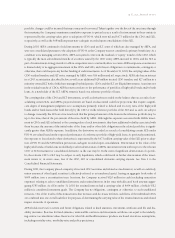American Express 2003 Annual Report Download - page 68
Download and view the complete annual report
Please find page 68 of the 2003 American Express annual report below. You can navigate through the pages in the report by either clicking on the pages listed below, or by using the keyword search tool below to find specific information within the annual report.
(p.66_axp_ financial review)
On September 30, 2003, AEFA acquired Threadneedle for cash of £340 million (approximately $565 million at September
30, 2003 exchange rates). AEFA received a $564 million capital contribution from the Parent Company for purposes of this
acquisition. Threadneedle is one of the premier asset management organizations in the United Kingdom. Threadneedle will
continue to manage certain assets of Zurich Financial Services, U.K., which constitute a substantial portion of Threadnee-
dle assets under management, for an initial term of up to eight years, subject to standard performance criteria. Effective Sep-
tember 30, 2003, $3.6 billion of owned assets and $3.0 billion of liabilities, and $81.1 billion of assets under management,
were consolidated into AEFA’s balance sheet and statistical information, respectively.
AEFA’s total assets and liabilities increased in 2003 primarily due to higher investments, client contract reserves and sepa-
rate account assets and liabilities, which increased mainly as a result of market appreciation. Investments primarily include
corporate debt and mortgage-backed securities. AEFA’s corporate debt securities comprise a diverse portfolio with the
largest concentrations, accounting for approximately 65 percent of the portfolio, in the following industries: banking and
finance, utilities, and communications and media. Investments also include $3.8 billion and $4.0 billion of investment loans
at December 31, 2003 and 2002, respectively. Investments are principally funded by sales of insurance, annuities and cer-
tificates and by reinvested income. Maturities of these investments are largely matched with the expected future payments
of insurance and annuity obligations.
Investments include $3.2 billion and $2.4 billion of below investment grade securities (excluding net unrealized apprecia-
tion and depreciation) at December 31, 2003 and 2002, respectively. These investments represent 8 percent and 6 percent
of AEFA’s investment portfolio at December 31, 2003 and 2002, respectively. Non-performing assets relative to invested
assets (excluding short-term cash positions) were 0.07% and 0.1% at December 31, 2003 and 2002, respectively. Manage-
ment believes a more relevant measure of exposure of AEFA’s below investment grade securities and non-performing assets
should exclude $236 million of below investment grade securities (excluding net unrealized appreciation and deprecia-
tion), which were recorded as a result of the December 31, 2003 adoption of FIN 46. These assets are not available for AEFA’s
general use as they are for the benefit of the CDO debt holders and reductions in values of such investments will be fully
absorbed by the third party investors. Excluding the impacts of FIN 46, investments include $2.9 billion of below invest-
ment grade securities (excluding net unrealized appreciation and depreciation), representing 7 percent of AEFA’s invest-
ment portfolio, and non-performing assets relative to invested assets (excluding short-term cash positions) were 0.01% at
December 31, 2003.
Assets consolidated as a result of the December 31, 2003 adoption of FIN 46 were $1.2 billion. The newly consolidated
assets consisted of $844 million of cash, $244 million of below investment grade securities classified as Available-for-Sale
(including net unrealized appreciation and depreciation), $64 million of derivatives and $15 million of loans and other
assets, essentially all of which are restricted. The effect of consolidating these assets on AEFA’s balance sheet was offset by
AEFA’s previously recorded carrying values of its investment in such structures, which totaled $673 million, $500 million
of newly consolidated liabilities, which consisted of $325 million of non-recourse debt and $175 million of other liabilities,
and $9 million of net unrealized after-tax appreciation on securities classified as Available-for-Sale.
The consolidation of FIN 46-related entities resulted in a cumulative effect of accounting change that reduced 2003 net
income through a non-cash charge of $13 million ($20 million pretax). The net charge was comprised of a $57 million
($88 million pretax) non-cash charge related to the consolidated CDO offset by a $44 million ($68 million pretax) non-
cash gain related to the consolidated SLTs.
The initial charge related to the application of FIN 46 for the CDO and SLTs had no cash flow effect on the Company. Ongo-
ing valuation adjustments specifically related to the application of FIN 46 to the CDO are also non-cash items and will be
reflected in the Company’s quarterly results until maturity. These ongoing valuation adjustments, which will be reflected
in operating results over the remaining lives of the structure subject to FIN 46 and which will be dependent upon market
factors during such time, will result in periodic gains and losses. In the aggregate, such gains or losses related to the CDO,
including the December 31, 2003 implementation charge, will reverse themselves over time as the structure matures,
because the debt issued to the investors in the CDO is non-recourse to the Company, and further reductions in the value
of the related assets will ultimately be absorbed by the third-party investors. To the extent losses are incurred in the SLT
























